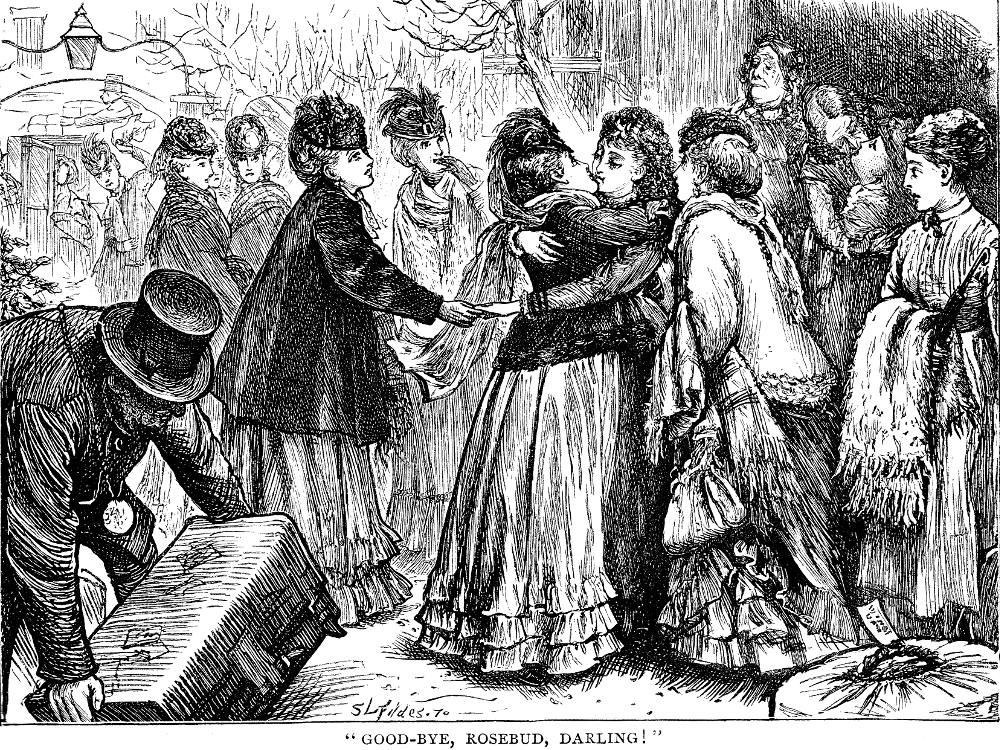[Click on these images for larger pictures.] Photographs and caption by the author. Formatting and perspective correction by George P. Landow. You may use these images without prior permission for any scholarly or educational purpose as long as you (1) credit the photographer and (2) link your document to this URL in a web document or cite the Victorian Web in a print one.]


Left: Chertsey's Gatehouse on a rainy February day. Right: John Jasper's Gateway (From the Cathedral) by F. G. Kitton from Walters, The Complete "Mystery of Edwin Drood"
Dating from the early fifteenth century, the gatehouse is the bachelor flat of Cathedral organist John Jasper in Dickens's last novel. Dickens features Chertsey's Gatehouse prominently among the "Cloisterham" locales of The Mystery of Edwin Drood (1870). Its open portal leads from the hustle and bustle of the commercially-oriented High Street of Rochester into the comparative quiet of the great Cathedral in an area known as the cathedral close. The timber house atop the alternating courses of local stone and flint was added when the porter's gate was converted into an actual &albeit, small — house in the eighteenth century — the Prior's Gate on the western side of the close suggests what Chertsey's might have looked like prior to that conversion.


Certainly in his illustration of the interior of the gatehouse for the novel "On Dangerous Ground" (Chapter 8, May 1870) (plate), Luke Fildes exaggerates the size of the dwelling in order to accommodate the figures of Edwin Drood, Neville Landless, and John Jasper.
Dickens and Fildes juxtapose the College Gatehouse, with its timeless and tranquil ecclesiastic associations and its implicit reference to his vocation as a choirmaster in the respectable Anglican provincial community, and Princess Puffer's opium den in the urban slum of the East End of London, sordid, foreign, exotic, and escapist.


Left: Under the Trees. Right: Jasper's Sacrifices both by Luke Fildes.
The appropriately named Nun's House from The Mystery of Edwin Drood, chapter 3 and elsewhere — in the garden of which Edwin chats affably with Rosa Bud in "Under the Trees," and in which later John Jasper declares his forbidden passion for Rosa in Fildes' "Jasper's Sacrifices" — corresponds to Eastgate House, just off the Rochester High Street, and not far from both Sapsea's House and Chertsey's (Jasper's) Gatehouse across the road. The building probably makes its first appearance in The Pickwick Papers as the girls' school whose precincts the do-gooding Pickwick violates in "The Unexpected Breaking Up of the Seminary for Young Ladies". In Dickens's last novel, it appears again, more prominently, as "Miss Twinkleton's Seminary"; the building, however, appears only as a backdrop — in Good-bye, Rosebud, Darling


Left: The Unexpected Breaking Up of the Seminary for Young Ladies. Right: Good-bye, Rosebud, Darling! by Luke Fildes.
An old-fashioned but visually pleasing Elizabethan townhouse of timber beams and a great deal of red brick, the building, dating from about 1590, is situated across the High Street from Sapsea's dwelling, both in The Mystery of Edwin Drood and in reality. Eastgate House was originally the home of local politician Sir Peter Buck, a naval official and quondam Mayor of Rochester.



Left: Eastgate House, Rochester by F. G. Kitton. Middle: The Chalet at Gadshill from Forster's biography. Right: The Chalet photograph by Jacqueline Banerjee.
The back garden is somewhat changed from its presentation in the novel in two respects: first, the hedges and bench shown by Fildes have been replaced by ponds and water gardens; second, for the time being at least, Swiss actor Charles Fechter's splendid Christmas 1864 gift to Charles Dickens, the Swiss Chalet in which the author loved to write in the "wilderness" (across the road and through a tunnel from Gad's Hill), is now located here. Frederic Kitton's rendering of Eastgate House is accurate, but more atmospheric than a modern photograph.
Bibliography
Langton, Robert. Charles Dickens and Rochester. London: Chapman and Hall, 1880. rpt. Rochester: Old Towns Books and Maps, 2009.
Walters, J. Cuming. The Complete "Mystery of Edwin Drood": The History, Continuations, and Solutions (1870-1912). London: Chapman and Hall, 1912.
Last modified 20 February 2012